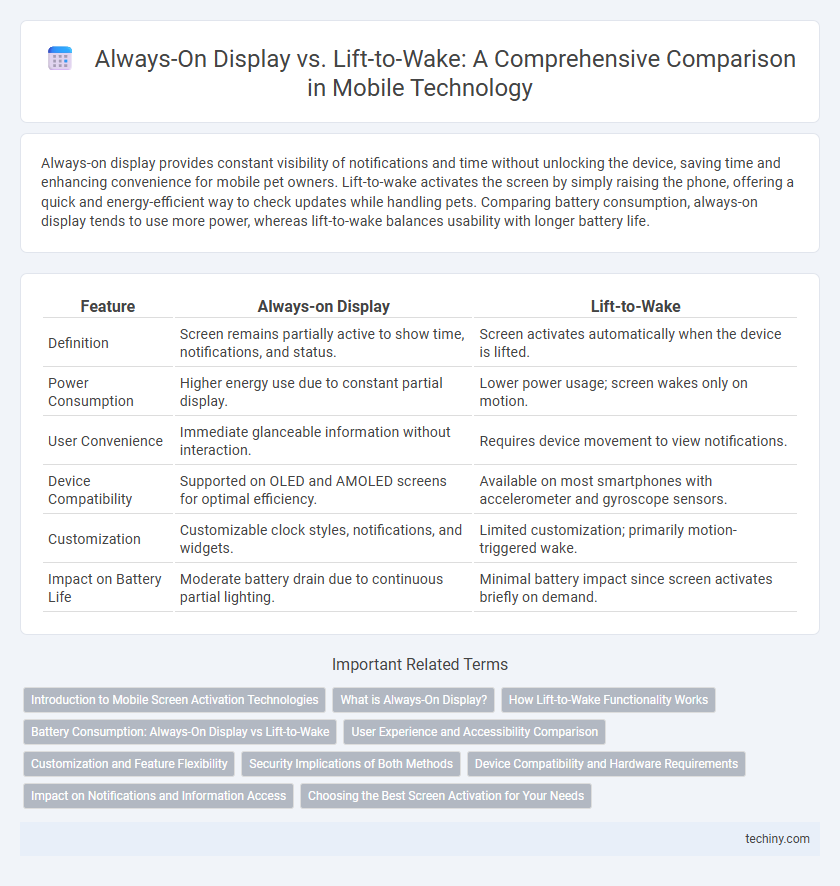Always-on display provides constant visibility of notifications and time without unlocking the device, saving time and enhancing convenience for mobile pet owners. Lift-to-wake activates the screen by simply raising the phone, offering a quick and energy-efficient way to check updates while handling pets. Comparing battery consumption, always-on display tends to use more power, whereas lift-to-wake balances usability with longer battery life.
Table of Comparison
| Feature | Always-on Display | Lift-to-Wake |
|---|---|---|
| Definition | Screen remains partially active to show time, notifications, and status. | Screen activates automatically when the device is lifted. |
| Power Consumption | Higher energy use due to constant partial display. | Lower power usage; screen wakes only on motion. |
| User Convenience | Immediate glanceable information without interaction. | Requires device movement to view notifications. |
| Device Compatibility | Supported on OLED and AMOLED screens for optimal efficiency. | Available on most smartphones with accelerometer and gyroscope sensors. |
| Customization | Customizable clock styles, notifications, and widgets. | Limited customization; primarily motion-triggered wake. |
| Impact on Battery Life | Moderate battery drain due to continuous partial lighting. | Minimal battery impact since screen activates briefly on demand. |
Introduction to Mobile Screen Activation Technologies
Mobile screen activation technologies such as Always-on Display (AOD) and Lift-to-Wake prioritize convenience and energy efficiency in modern smartphones. AOD maintains a low-power screen state to show essential information without fully waking the device, while Lift-to-Wake uses the phone's accelerometer sensor to activate the screen upon detecting motion. Both technologies enhance user experience by enabling quick access to notifications and time without pressing physical buttons, optimizing power consumption tailored to different usage patterns.
What is Always-On Display?
Always-On Display (AOD) is a mobile technology feature that keeps a portion of the screen illuminated to show key information such as time, date, notifications, and battery status without fully waking the device. This functionality uses low-power display techniques, often employing OLED screens to minimize energy consumption while providing constant visibility. Always-On Display enhances user convenience by enabling quick glances at essential data without needing to unlock or activate the phone.
How Lift-to-Wake Functionality Works
Lift-to-wake functionality employs the smartphone's accelerometer and proximity sensors to detect when the device is lifted or raised, triggering the display to turn on automatically. This sensor-based activation conserves battery life by only illuminating the screen when the phone is physically moved. Unlike Always-on display, which keeps the screen partially active, lift-to-wake activates the full display only during user interaction.
Battery Consumption: Always-On Display vs Lift-to-Wake
Always-on display continuously uses power to keep pixels illuminated, resulting in higher battery consumption compared to lift-to-wake, which activates the screen only when the device is lifted. OLED and AMOLED screens minimize energy use in always-on mode by lighting individual pixels, but the overall drain remains significant over extended periods. Lift-to-wake leverages motion sensors to conserve battery life by keeping the display off until necessary, offering a more energy-efficient solution for mobile devices.
User Experience and Accessibility Comparison
Always-on display enhances user experience by providing constant access to notifications and time without interaction, benefiting users who need quick information at a glance. Lift-to-wake improves accessibility by automatically activating the screen when the device is raised, reducing the need for button presses and accommodating users with limited dexterity. Both features optimize energy usage differently while catering to diverse user preferences for convenience and ease of access in mobile technology.
Customization and Feature Flexibility
Always-on display offers continuous visibility of key information with extensive customization options like brightness, clock styles, and notifications, allowing users to tailor their experience without unlocking the device. Lift-to-wake activates the screen automatically when the device is lifted, focusing on convenience but providing limited customization beyond sensitivity settings. Prioritizing feature flexibility, always-on display excels in personalization, while lift-to-wake emphasizes energy efficiency and quick access.
Security Implications of Both Methods
Always-on display continuously shows notifications and information on the screen, increasing the risk of sensitive data exposure if the device is left unattended. Lift-to-wake activates the screen only when the phone is lifted, reducing the chance of unauthorized viewing but may still present vulnerabilities if facial recognition or biometric unlock triggers unintentionally. Both methods require strong lock screen security measures such as PINs or biometric authentication to mitigate potential privacy risks.
Device Compatibility and Hardware Requirements
Always-on display requires OLED or AMOLED screens to efficiently light individual pixels without draining battery, making it less compatible with older LCD devices. Lift-to-wake relies on accelerometers and gyroscopes to detect motion, enabling broader compatibility across various hardware types, including LCD and OLED smartphones. Devices with advanced sensors and energy-efficient displays deliver the best performance for these features, influencing user choice based on hardware capabilities.
Impact on Notifications and Information Access
Always-on display continuously shows notifications and essential information without unlocking the phone, enabling instant access and reducing missed alerts. Lift-to-wake activates the screen only when the device is lifted, conserving battery life but potentially delaying notification visibility. Comparing both, always-on display prioritizes real-time information access while lift-to-wake emphasizes energy efficiency with slightly slower notification awareness.
Choosing the Best Screen Activation for Your Needs
Always-on display conserves convenience by showing key information without unlocking the phone, ideal for users seeking constant visibility with minimal interaction. Lift-to-wake activates the screen through motion sensors, offering a quick, intuitive way to view notifications, best suited for those who prioritize battery efficiency and discrete screen use. Selecting between these technologies depends largely on balancing battery consumption against the frequency and ease of access required in daily mobile usage.
Always-on display vs Lift-to-wake Infographic

 techiny.com
techiny.com